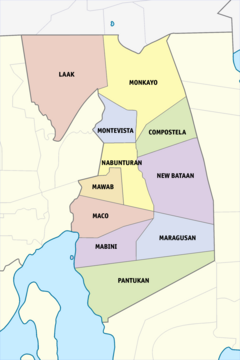Davao de Oro
It was formerly known as Compostela Valley (shortened to ComVal; Cebuano: Kawalogang Kompostela) from its inception until December 2019, when a plebiscite ratified the law that proposed to rename the province to Davao de Oro.The movement to create a new province by dividing Davao del Norte started in the 1980s during the time of Congressman Lorenzo S. Sarmiento Sr., himself the author of RA No.However, the House of Representatives’ Reference and Research Bureau, which conducted the research and legal work on the creation of the province, found out that the mother province continues to be officially referred to as Davao del Norte in most official documents including the 1987 Philippine Constitution despite the passage of RA No.The proposal was thus shelved and the name finally agreed upon was Compostela Valley, referring to the great fertile plain in the heartland of the province.The origin of the province’s inhabitants came from the ethnic tribes of the Mansaka, Mandaya, Manobo, Mangguangan, Dibabawon, Aeta, Kamayo, Davaweño and Kalagan.The bigger wave of immigrants came during the time of President Ramon Magsaysay wherein the policy of attraction adopted by the national government was to offer parcels of land to tenant-farmers.In the same year the sitios of Kao, Magkagong, Margosan, Matilo, Magangit, Cabacungan, Tigbatinao and Camanlangan were constituted into a barrio known as Santo Niño.[7] At the time, Compostela was an incongruous mixture of wooden-roofed houses concentrated along the Agusan River which was properly known as "dungguanan" (embarkation).Provincial officials led by Governor Jayvee Tyron Uy justified the renaming as part of an clear up confusion with its geographic location, with the province's name sometimes associated with Cagayan Valley and the town of Compostela in Cebu, and associate it further with fellow provinces in the Davao Region.According to legends, 40 days after his death, his bodily spirit was infused into the statue of Ara-Araba, the local tribe's god of harvest.[22] That year, its provincial government posted a record high of ₱18.75 billion worth of assets, the largest in whole Mindanao.The main sources of livelihood in the province are agricultural products such as rice, coconut, cacao, coffee, papaya, mango, pineapple, durian and banana.
Political map of Davao de Oro
ProvinceNabunturan PoblacionMontevista Sports ComplexCountryPhilippinesRegionDavao RegionFoundedNabunturanMonkayoGovernorDorothy Montejo-GonzagaVice GovernorJayvee Tyron L. UyLegislatureDavao de Oro Provincial BoardMt.PandadagsaanDemonym(s)Component citiesMunicipalitiesCompostelaMabiniMaragusanMontevistaNew BataanPantukanBarangaysDistrictsLegislative districts of Davao de OroTime zonearea codeISO 3166 codeCebuanoMansakaAta ManoboMandayaFilipinoEnglishMindanaoDavao del NorteAgusan del SurDavao OrientalDavao Gulfa plebisciteRepublic ActFidel V. RamosplebisciteProspero S. AmatongHouse of Representatives1987 Philippine ConstitutionManoboKamayoDavaweñoKalaganTagalogsBataanIlocanosRamon MagsaysayVisayansAsuncionCarlos P. GarciaAgusan RiverPoblacion2019 Compostela Valley renaming plebisciteCagayan ValleyDistrictCoordinatestown centerlatitudeReligion in the PhilippinesRoman CatholicismIglesia ni CristoSunni IslamAnimismPhilippine Statistics AuthoritytilapiamilkfishSangguniang BayanHouse of Representatives of the Philippinescongressional districtRegional Trial CourtDorothy GonzagaRepormaJayvee Tyron UyHugpong ng PagbabagoPDP-LabanGMA News OnlineSunStar DavaoBusinessWorldOpenStreetMapDavao Region (Region XI)Regional centerDavao CityProvincesDavao del SurDavao OccidentalMetro DavaoPanaboMalitaBagangaBanaybanayBansalanBostonBraulio E. DujaliCaragaCarmenCateelDon MarcelinoGovernor GenerosoHagonoyJose Abad SantosKapalongKiblawanMagsaysayMalalagMatanaoNew CorellaPadadaSan Isidro (Davao del Norte)San Isidro (Davao Oriental)Santa CruzSanta MariaSanto TomasSaranganiTalaingodTarragona